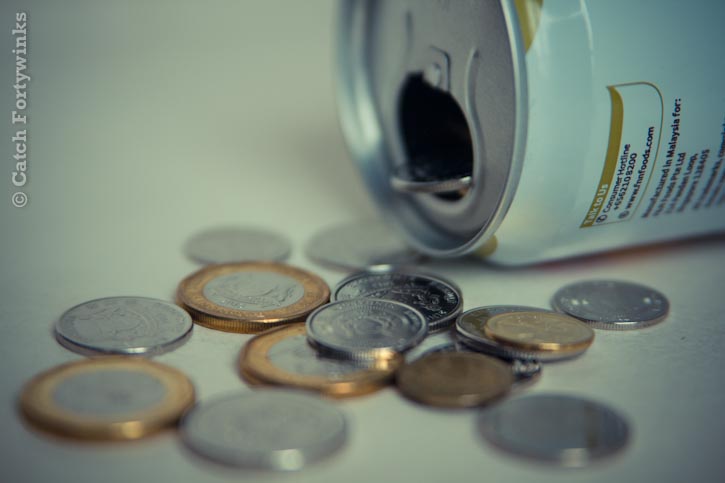
This is the first Chinese New Year that K will be able keep the money in the red packets that are given to him. For previous years, hb and I have been rather sneaky to pocket the money to make up for the ‘losses’ on our end, besides, the little boy didn’t quite understand the value of money then.
This year, we are doing things a little differently.
For a start, we don’t have plans to visit relatives, all except my dad and his family and my MIL. So it wouldn’t be exactly a big bountiful harvest of red packets for him, however, he will get to keep all the money from his red packets this time round.
After getting almost 4 weeks worth of pocket money, he seems to be getting into the groove of spending and saving money, and I have found him pouring out all the money he has in his ‘can-coin bank’ and counting them, at least twice in these 4 weeks. And he has never taken a single coin from it to spend, not once.
He has glee-fully announced that he has has $31.00 worth of new coins in his can.

Earning his money
I don’t reward him for picking up his dirty clothing and putting it in the laundry basket, clearing his toys after play or helping with any form of chores at home. I wouldn’t give him extra money for doing things that are part of his responsibility. And he would likely find that he has to do them for the rest of his life, so I do not want to give him the wrong message that he will be doing these things at home, just because he will get something out of it.
I don’t believe in rewarding him for good results in school either. He need to know how to intrinsically motivate himself to learn, and not be pushed to learn or do well academically through extrinsic rewards.
He is however, allowed to look through my coin purse for new coins, if there is a positive review of his overall behavior at the end of the week.
Just last week, he has been penalized for lack of self-control and did not get any extra new coins from my coin purse, and had game-time deducted from playing on the iPad/PS3 to only 30 mins during the weekend.
I don’t pressure him to save more daily. He is given the freedom to decide what he wants to eat. He has only once, since school started, bought a ‘sweet’ drink, while all other days he has been contented with drinking water from his water bottle and has bought 1 eraser from the school bookstore.
At the end of each week at school, he will have a dollar or more saved from his pocket money, so he will change the coins for a shiny new coins to add to his can-coin bank.

His coins in this Fruit Tree can is about 3/4 filled and he hasn’t taken any out to spend since he started saving since 5 months ago.
‘For the love of money is the root of all evil…’
You must have heard this saying before, that is from the bible by the way.
I can probably write a whole thesis about how the love of money is the root of all evil. From how families are being destroyed by divorces as the result of financial issues. Or how men through the ages have laid their lives to serve money. Some cheat and deceive many, while others are driven to commit crime for the sake of money. Or how the world tags a social status to how much money or material things one own.
Money in itself isn’t evil, it is only when one loves money (greed) then it becomes the root of all evil.
As a parent, I see the importance of teaching my child about money at age 6. So to prepare him to make good financial choices ahead, ensure that his money habits leans towards being more of a thrifty person, rather than a spendthrift. And how to help him NOT to be be a ‘money-face’, materialistic adult.
What to do with Savings?
I have asked him what will he plan to do with the money once the can is full to the brim.
He has said that he wants to give the money to the poor and then keep aside enough for buy just 1 toy for himself. I was rather surprised with his response, as he has always been rather stingy with the money he has saved. Looks like watching videos of poor and less fortunate people and discussing about how we can help them, has helped educate him that it is a blessing to give to others.
So, we will be setting aside a percentage of his savings to give to the poor. Some savings will go into his POSB Savings bank and he can still buy the toy that he wants.

Apart from occasions like Christmas or his birthday, he does not get toys all other times. I think buying for him whatever he wants will not help him at all, instead he will learn to earn and help pay for the things himself from his allowance. Also with the ‘new’ economy that we are living in these days, he needs to learn how to delay gratification, stretch the ‘dollar’ and live beneath his means.
So likely all money got from the red packets from CNY this year will go into his savings. And in the next few months, I will start giving him a weekly allowance, to see how he will learn to budget his pocket money weekly.
How do you teach your child to manage money? Do share.




 This art workshop will introduce two types of clay and its characteristics, and will encourage the development of fine motor skills in the molding and sculpting techniques of clay art. In completing the clay creation, the child will be exposed to the appreciation of color and painting on clay textures.
This art workshop will introduce two types of clay and its characteristics, and will encourage the development of fine motor skills in the molding and sculpting techniques of clay art. In completing the clay creation, the child will be exposed to the appreciation of color and painting on clay textures.




















